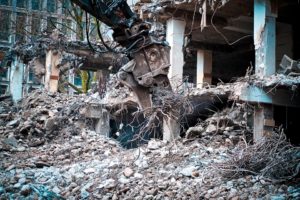A while back, we talked about using infrared thermal imaging technology in roofing and since, many people have contacted me asking about the use of this great innovative technology in other areas of construction. Guys, just to make one thing clear: this imaging can be used in any situation during which you need information on thermal activity, or something that is behind a wall etc. So the simple/short answer for the deconstruction question, would be: absolutely!
You can pretty much find applications for anything you want in your daily life. So that is not the correct question. The right question you need to ask is: what are some specific applications of it that are going to help versus something else we do in its place?

Well, when it comes to demolition the range of uses can be from identifying places of a building that have increased temperature (that may be due to gas leaks and material disturbance) all the way up to discovering a trapped worker under debris. In the first case, a demolition contractor would have to go in with machinery and remove all those structures in a very surgical way, before he moves on to deconstruction or implosion. In the second case…well that would be a great tragedy, so I won’t talk too much about that.
There aren’t any cookie cut applications for you when using thermal imaging in construction (and demolition since this is what we’re talking about.) Pretty much you need to think of the activities you conduct on a daily basis on your deconstruction site and think of areas where that would help you. Not all demolition companies will need this technology (and honestly, it isn’t that expensive to acquire it either.) My guess is that the larger companies and contractors will need this because of big implosions and tons of concrete being taken away from the buildings. But if you are doing like asbestos abatement most likely you don’t need thermal imaging. So don’t spend your money on that.
Since I know you are kind of waiting for me to give you some ideas, that will be what I do:
When the excavators with the large “teeth” start banging against the metal structures there can be an increased temperature due to the increased tension between the materials (that is why you see the workers spraying water on the buildings while the excavator is pulling it down piece by piece.) Thermal imaging can be very helpful to identify extremely hot metals so that you don’t have any accidents (and don’t touch a piece of steel you probably shouldn’t.) But of course that isn’t the most important reason someone should invest in this technology. Probably the most important reason a demolition company should use thermal imaging (and any contractor for that matter) is for electrical inspections. Although all power is shut down before demolition starts, there can be some reasons for a line being still hot. So using your infrared thermal imaging, you will be able to figure out which ones are still active and disable them.
Can you imagine your labor force going in and being struck by electricity or starting a fire on the building, just because someone forgot to pull the plug? That could create massive explosions that not only will it harm the demolition crew, but also neighboring buildings and civilians. Not only that, but afterwards the legal implications of doing such damage to so many people and possibly other buildings are going to be horrifying.
So either get someone who knows everything about electricity and getting the lines disabled, or cough up some change to make sure you can do this your self and verify that the building is clear (regardless of whether you perform implosion or deconstruction.)
Have any questions? Let us know! Please come back for more, as we will be expanding the use of infrared thermal imaging to other industries as well in the upcoming articles. We appreciate all your support!